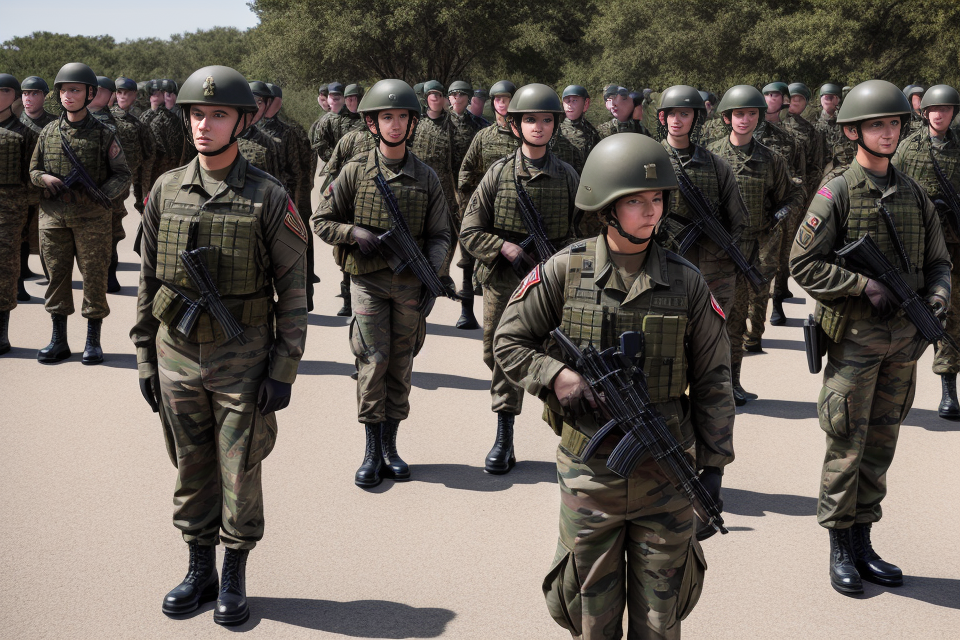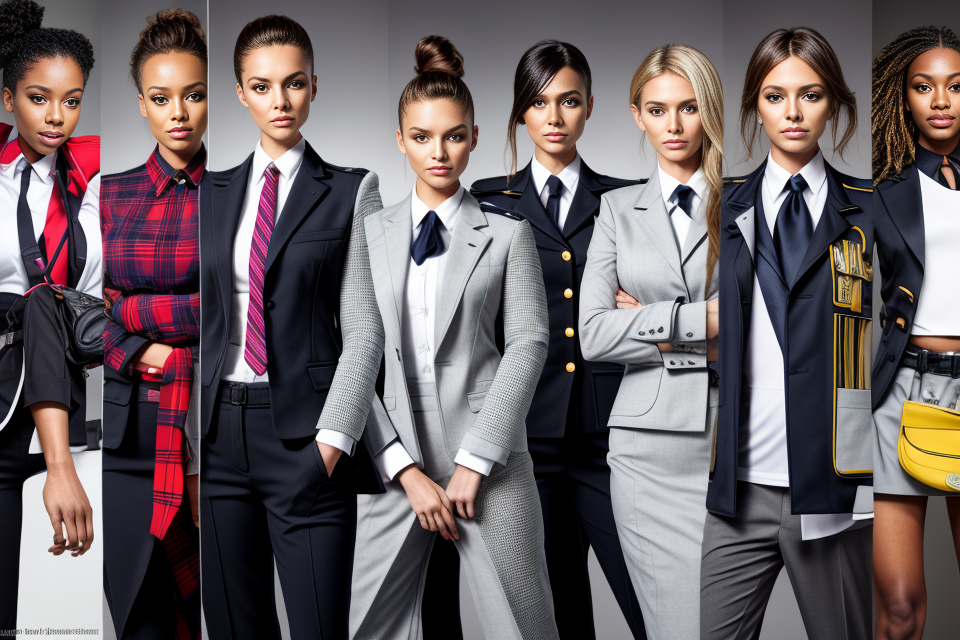
The military is an organization that is built on discipline, order, and a clear chain of command. Uniformity plays a crucial role in maintaining these elements and ensuring that the military operates smoothly. From the way soldiers dress to the way they address each other, uniformity is a vital component of military life. But why is it so important? In this article, we will explore the purpose of uniformity in the military and how it contributes to the overall effectiveness of the organization. We will delve into the history of military uniforms, the role they play in fostering a sense of camaraderie and unity, and how they help to establish a clear hierarchy. So, buckle up and get ready to learn about the fascinating world of military uniformity.
Uniformity is important in the military because it promotes a sense of unity and cohesion among service members. When everyone wears the same uniform, it creates a level playing field and eliminates social hierarchies based on clothing or appearance. This helps to foster a sense of camaraderie and teamwork, which is essential for successful military operations. Additionally, a standardized uniform ensures that all service members are easily identifiable as members of the military, which is important for maintaining discipline and order. Finally, a uniform can help to instill a sense of pride and belonging among service members, as they represent a common goal and a shared commitment to serve their country.
Uniform Functionality
Standardization
Uniformity in the military is essential for standardization. By wearing the same uniform, all military personnel create a sense of unity and belonging. This helps to foster a strong sense of camaraderie and teamwork among service members. Additionally, the standardization of uniforms ensures that everyone is wearing appropriate clothing for their role. This eliminates any confusion or ambiguity about what type of clothing is appropriate for a particular job or task. Standardization also simplifies logistics and procurement, as uniforms can be mass-produced and distributed to service members efficiently.
Identification
Another critical aspect of uniform functionality is identification. Military uniforms serve as a means of identifying personnel quickly and easily. This is particularly important in combat situations, where it may be difficult to distinguish between friendly forces and enemy forces. Uniforms with distinctive insignia or rank identifiers make it easier to identify personnel and ensure that orders are being followed by the appropriate individuals. Moreover, the use of uniforms differentiates military personnel from civilians, which is crucial for maintaining discipline and order. Finally, the identification provided by uniforms facilitates accountability and the command structure, as superiors can easily identify their subordinates and assess their performance.
Military Discipline
Adherence to Rules
In the military, adherence to rules is essential for maintaining order and discipline. By following established regulations and procedures, soldiers demonstrate their respect for authority and tradition. This uniformity reinforces the military hierarchy and ensures that everyone understands their role and responsibilities within the organization.
- Reinforces military discipline and hierarchy: A clear chain of command is crucial for effective military operations. By adhering to rules, soldiers demonstrate their commitment to the hierarchy and the chain of command. This helps to maintain order and discipline, even in challenging and stressful situations.
- Demonstrates respect for authority and tradition: The military has a long and storied history, and respect for tradition is an important part of the culture. By following rules and regulations, soldiers demonstrate their respect for the institution and the men and women who came before them.
- Ensures adherence to regulations and procedures: The military is a highly structured organization, and every member must follow established procedures and regulations. By adhering to rules, soldiers help to ensure that the military runs smoothly and efficiently. This is particularly important in high-pressure situations, where clear and consistent procedures can mean the difference between success and failure.
Psychological Impact
Group Identity
In the military, uniformity plays a crucial role in fostering a sense of belonging and loyalty to the group. When all members of a unit wear the same uniform, it creates a visual representation of the collective identity of the group. This shared identity is important for building unit cohesion and morale, as it creates a sense of belonging and commitment to the mission.
Moreover, uniformity reinforces the idea of collective identity by signifying that all members of the group are working towards a common goal. It helps to create a sense of pride and accomplishment among military personnel, as they can see the tangible results of their efforts in the form of their uniform.
Trust and Respect
Uniformity in the military also establishes trust and respect among military personnel. When everyone is held to the same standards, it creates a sense of fairness and equality within the group. This helps to build trust among members of the unit, as they know that everyone is being treated fairly and equally.
Additionally, uniformity signifies that all members of the military are committed to the mission and the values of the organization. This helps to establish respect among members of the unit, as they recognize the importance of working together towards a common goal.
Overall, the psychological impact of uniformity in the military is significant. It helps to build unit cohesion and morale, reinforces the idea of collective identity, and establishes trust and respect among military personnel. By promoting a sense of belonging and commitment to the mission, uniformity plays a crucial role in the success of the military as a whole.
Practical Considerations
Safety and Security
Uniformity plays a crucial role in ensuring the safety and security of military personnel. One of the primary reasons for this is that it helps to ensure visibility and identification in combat situations. When all members of a unit are wearing the same uniform, it is much easier to quickly identify friend from foe, which can be a life-saving advantage in the heat of battle. Additionally, wearing a uniform helps to minimize the risk of accidents and mishaps, as it allows for easy identification of personnel and can help to prevent friendly fire incidents.
Furthermore, uniformity is also important for enhancing security and force protection. When all personnel are wearing the same uniform, it becomes much easier to spot anyone who does not belong, which can help to prevent unauthorized access to sensitive areas. Additionally, wearing a uniform can help to deter potential threats, as it signals that the wearer is a member of a highly organized and disciplined force.
Operational Effectiveness
Uniformity is also important for enhancing operational effectiveness in the military. One of the primary reasons for this is that it facilitates communication and coordination among units. When all personnel are wearing the same uniform, it is much easier to quickly identify key personnel and to communicate effectively. This can help to streamline operations and ensure that everyone is working together towards a common goal.
Additionally, uniformity can also help to streamline logistics and support operations. When all personnel are wearing the same uniform, it is much easier to issue supplies and equipment, as well as to maintain and repair these items. This can help to ensure that everyone has the resources they need to do their job effectively, which can be critical in the often fast-paced and high-pressure environment of military operations.
Finally, uniformity is also important for simplifying coordination with civilian authorities. When all personnel are wearing the same uniform, it is much easier to establish a clear chain of command and to ensure that everyone is aware of their roles and responsibilities. This can help to prevent confusion and misunderstandings, which can be critical in situations where time is of the essence.
FAQs
1. What is the purpose of uniformity in the military?
The purpose of uniformity in the military is to establish a sense of identity, unity, and discipline among service members. The use of standardized uniforms helps to create a cohesive and organized military force, which is essential for the effective execution of military operations.
2. Why is uniformity important in the military?
Uniformity is important in the military because it promotes a sense of belonging and pride among service members. Wearing the same uniform as one’s fellow soldiers creates a sense of camaraderie and shared purpose, which is crucial for building teamwork and esprit de corps. Additionally, standardized uniforms help to establish a clear chain of command and hierarchy within the military, which is essential for maintaining order and discipline.
3. What are the benefits of wearing a military uniform?
The benefits of wearing a military uniform include the establishment of a clear identity as a member of the military, the promotion of a sense of pride and belonging, and the creation of a unified and organized military force. Additionally, wearing a military uniform can help to establish trust and credibility with the public, as well as with foreign militaries and governments.
4. Are there any restrictions on what service members can wear in the military?
Yes, there are strict rules and regulations regarding what service members can wear in the military. These restrictions are in place to maintain the integrity and professionalism of the military, as well as to ensure the safety and readiness of service members. Violations of these rules can result in disciplinary action.
5. Can service members customize their uniforms?
While there may be some limited options for personalization, such as adding rank or name tapes, service members are generally not allowed to customize their uniforms in any significant way. This is because the standardized appearance of the military uniform is an important part of the military’s identity and discipline. Any deviation from the standard uniform could undermine the cohesion and unity of the military force.


